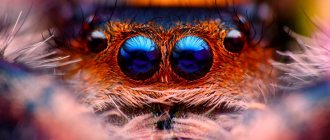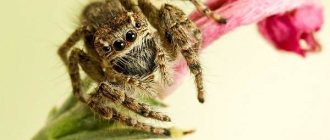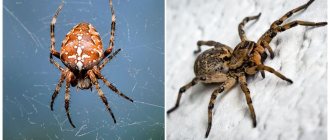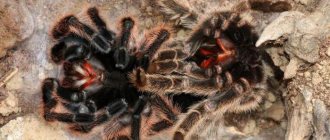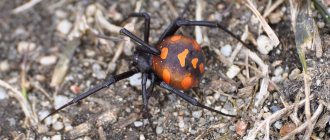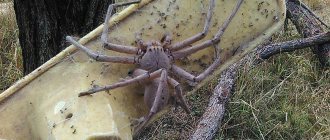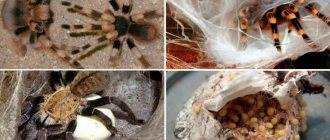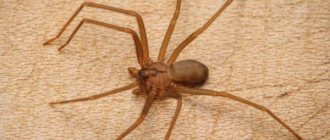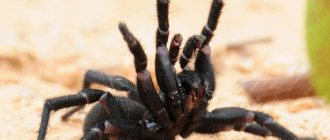It is no coincidence that the appearance of jumping spiders evokes the idea of danger to humans.
Because the very behavior of this creature seems reasonable due to its almost human-meaning look.
Spider jumping
One can say about the amazing features of jumping spiders: despite the fact that the family Salticidae (jumping spiders, or jumping spiders, or jumping spiders) is included in the order Spiders (Araneae), its representatives are more like crabs.
Description of the spider
Jumping spiders are characterized by a wide variety of habitats: tropical forests, temperate zones, semi-deserts, deserts or mountains.
Jumping spiders look like this:
- they have a broad fusion of head and thoracic segments, decorated with a white pattern.
- The fused segments of the abdomen are covered with villi, oval in shape, covered with stripes of white and black, which alternate with each other.
- There are 4 pairs of large eyes located on the head. They are responsible for the clear vision of this arachnid. Thanks to them, jumpers have excellent vision and accurately identify the location of the prey. They are also able to distinguish colors.
- The size of the jumping spider varies depending on gender. Females are always larger - their body reaches 7-8 mm. Males are 1 mm smaller.
- The paws of jumpers are well developed. They also distinguish between males and females. Males have stripes on the front pair of limbs, while females do not have them. The second pair of limbs (tentacles) is small, but quite powerful.
The tentacles, together with the front pair of limbs, help arthropods to be communicative. Arachnologists have already managed to decipher about 20 signals that these spiders use to communicate.
What does it look like
The horse has eight pairs of eyes located on the front part of the cephalothorax. They provide this creature with uniquely clear vision, allowing it to determine the shape, color of objects, and the exact distance to them. In the middle there are two pairs of large central and one pair of small lateral eyes. The top row consists of two very small eyes, and the bottom row consists of two medium-sized eyes located at the junction of the head and chest. This structure of the visual apparatus gives the horse an almost all-round view.
Important! If you want to catch a horse or get a better look at it, approach it very slowly. This arthropod reacts to small fussy movements and quickly runs away.
It is unable
to notice The abdomen has an oval shape, the color is black and white, striped, which is why the horse is sometimes called a zebra spider. The cephalothorax is massive, shaggy, mostly white. Sexual dimorphism is expressed implicitly. The male's body length is 5 mm, the female's is 6 mm.
In total, the horse has eight legs and one pair of powerful pedipalps. This arthropod uses the front pair of legs and pedipalps for signal communication with relatives.
Behavior
The jumping spider leads an active daytime lifestyle. He is able to expand his limbs against a background of changing blood pressure (internal hydraulic system).
With this in mind, there is no doubt about whether spiders are jumping spiders. They are able to do this over long distances, which significantly exceed the size of their own body.
When making a jump, the spider attaches a silk thread of the web to the supporting place for safety. Horses also hold their bodies on horizontal glossy surfaces (glass). This is possible thanks to the small hairs and claws located on the paws.
When fleeing, jumping spiders often turn around, assessing the distance to the one who is pursuing them. It is usually not difficult to hide from an enemy, since their limbs are well developed.
Thanks to its powerful limbs, the arachnid not only successfully runs, but also jumps over considerable distances.
The jumping spider is found in such areas:
- forests attract him with trees, any of which he can make his home;
- mountains or steep cliffs are also interesting for him - there are cracks for his shelter;
- fields attract him with tall grass or branches of bushes;
- a person’s home can also become his home, since there is always a cozy sunny place for him there.
Jumping spiders are loners. They are most active during the day, and at night they look for some hidden place. To spend the night, the horse weaves a cradle from a web, lays down in it and rests there until the morning. With the advent of the first rays of sunlight, the horse awakens.
If it is not satisfied with weather conditions, the spider may decide not to leave its shelter for several days.
After waiting out the bad weather and seeing noticeable improvements in weather conditions, the horse leaves its cradle, warms up in the sun for a while, and then goes hunting.
Some species of jumping hoppers imitate ants. Mimicry (resemblance) is expressed not only in imitating the shape of the body, but they also repeat their movements. Thanks to this, horses are saved from road wasps that actively hunt them.
Habitat
Jumping spiders live almost everywhere. The habitat varies greatly and depends on the species. Most species prefer tropical forests, but some species live in temperate forests, semi-deserts and deserts. You can even meet a spider in the mountains. For example, in 1975, the species Euophrys omnisuperstes was discovered on the summit of Mount Everest. Jumping spiders are found in Australia (Queensland, New South Wales), Africa, North America, New Guinea, etc.
They can hide in fallen leaves, walls, soil or even trees. The jumping spider prefers sunny places.
Hunting and food
The jumping spider uses its silk thread both to create a lullaby and to protect laid eggs. But he does not catch his victims with the help of a web, but runs after them.
The predator sits motionless for a long time, inspecting the territory. Noticing minor fluctuations, the spider slowly turns its head in that direction.
His main pair of visual organs focuses on the source of noise in order to determine the distance to it. Then the horse slowly approaches the prey.
It freezes behind or to the side of the victim, after which it makes a dynamic jump. It grabs prey with the first pair of limbs and bites into the chitinous cover with its jaws. The horse then injects poison and digestive juices into its victim.
The horse's nutritional diet includes:
- insects from the order Diptera;
- medium-sized Coleoptera;
- blood-sucking mosquitoes;
- ant.
These arachnids received the name “horses” precisely because of their method of obtaining food. If the fart fails to accurately calculate the distance to the victim, then it will simply remain hanging on the web, which is stronger than steel of the same diameter.
Kinds
The types of jumping spiders are quite diverse. In the process of evolution, some varieties received the most widespread, some unusual features:
- Golden jumping spiders from the genus Simaetha resemble jewels. Their attractive golden, purple, and violet colors are difficult to notice due to their tiny size. These inhabitants of southeast Asia grow to a maximum of 4 mm.
- The jumping ant Myrmarachne plataleoides also lives in southeast Asia. Amazingly disguises itself as a weaver ant, known in nature for its aggressive behavior. Also, such mimicry protects against attacks by birds and wasps. Dark spots on the modified chelicerae imitate the eyes of an ant. Ant jumping spiders live in the jungle on the same trees as ant colonies. Sitting on the underside of the leaf, they look out for their victims.
- The red-backed jumping spider is considered the largest representative among its kind on the North American continent: the size of the female is up to 22 mm, the male is up to 15 mm. Lives in dry forests, in sand, under stones. Builds tubular nests from spider webs, especially noticeable in vineyards. The male has a completely red back, while the female has a black stripe in the middle. Externally, the red-backed jumper resembles the highly poisonous Latrodectus hasselti, known as the Australian black widow.
- The Himalayan horse, discovered at the beginning of the 20th century, is capable of living at an altitude of 6,700 m. The body is brown in color, in females up to 0.35 cm long, in males - up to 0.4 cm. They feed on small midges and tiny springtails that live in the soil .
- The pied racer Salticus scenicus is distributed throughout the Northern Hemisphere. The body of males and females is almost the same size: 6 and 7 mm, respectively. The color is black, white and gray, the body and limbs are pubescent. They live next to a person. These spiders can often be seen basking in the sun on the stone walls of houses.
- The green racer Mopsus mormon lives exclusively in Australia and New Guinea. the body is translucent, bright green, yellowish in color. Performs the most intricate mating dance among its relatives. Reaches a size of 1 cm.
- The peacock spider Maratus volans is also found in Australia On its abdomen there are scutes that are brightly colored. During the mating dance, the scutes open like a fan to attract a potential mate.
- The muscular racer Hyllus diardi also lives in the tropical rainforests of Asia. A very large representative of the family. The body size reaches 2 cm, the leg span is 3 cm.
Interesting fact! New endemic species of jumping spiders are still being discovered in Australia.
Reproduction
The mating season for horses lasts from May to September. At this time, males attract females by dancing. This mating ritual involves the following: the male raises his body, after which he hits it with his front paws at regular intervals.
If several males gather near a female at once, then they will not come to the point of fighting. They compare their tentacles with each other.
The winner is the one with the largest ones. He continues to perform the mating dance, drawing intricate circles around his future partner.
Sometimes males find a female who has not yet reached sexual maturity. Even before the last molt, she is still entangled in web fibers. In this case, the jumping spider does not leave her, but waits patiently until she becomes sexually mature, and then begins her dance.
The female is attracted to such actions, and she allows the male to fertilize herself. Before the mating process, the male weaves a small net and leaves a few drops of seed on it.
Then he plunges the tentacles into it and soaks them with sperm. Now he is completely ready to transfer male reproductive cells into the body of his partner.
After this, the female hides in a shelter and begins to weave a nest. A secluded place for it can be: leaf litter, cracks in tree bark, stones or substrate. There she, using her silk threads, weaves a cradle for future offspring.
After laying eggs, the female does not leave the nest, but waits for the babies to be born . It is removed after the spiderlings get out of the silk cocoon.
The young animals do not expect to be fed by adults and immediately begin hunting. Before they mature, they go through several molts. And when they become sexually mature, they repeat the reproduction cycle characteristic of their species.
Is it possible to keep at home?
Yes, you can. An aquarium would be an excellent home for a spider. It is filled with soil mixture. To prevent the soil from drying out, it should be irrigated frequently, but the water should not get on the pet. To make your pet more comfortable, you should put leaves and branches in the aquarium. Fresh water is a must.
The spider needs to be fed regularly. Provide him with a full diet of various insects (change the menu constantly). It is advisable to serve the food crushed and dry. But if you want to entertain your pet and develop its instincts, you can throw live prey into the aquarium. A great option is cockroaches.
Sometimes the spider refuses to eat. Reasons 4:
- He is not hungry.
- About to shed.
- The maintenance conditions are violated (not enough fresh air enters the aquarium).
- You give your pet little water or poor quality food. Try giving him live prey.
A female is more suitable for keeping than a male. It is larger in size. It is very interesting to care for and watch how she will hunt. In addition, the female is not so picky about her living conditions, and can easily tolerate temperature changes (she is able to survive even in mild frost). And the life expectancy of a female is twice as long as that of a male (4 years, while the male has only 2).
If you add a male to a female, you can raise a whole offspring of children. But you have to be careful here. During mating seasons, spiders are very aggressive, especially during gestation. If you make a mistake, there is a risk of being bitten. And remember, to create the comfort necessary for reproduction, it is necessary that the spider enjoys living in the cage, and the food is varied (beetles, flies, larvae).
The wolf spider is an interesting inhabitant of our planet. It is only dangerous if disturbed. And if a person loves such insects, you can take it as a pet. The main thing is not to violate the rules of keeping, then there will be no risk of being bitten.
https://youtube.com/watch?v=8fi-jK00-bA
Importance in the ecosystem
Jumping spiders belong to the orderlies of garden plots. They benefit gardeners because they destroy pests, protect fruit trees, bushes with berries or beds from attacks by wood-eating beetles, elephant beetles, and also from large cabbage weeds.
Some gardeners specifically plant jumping spiders in their summer cottages. This eliminates the need for pesticides or other harmful chemicals.
This arthropod has high intellectual abilities, so some consider it as a pet. In captivity, the jumper lives up to 3 years.
It brings considerable benefits by destroying aphids on flowerpots. They do not move around the living space, but live in the flowerpot that the owner has chosen for them.
Video
Spiders are long-lived
Common house spider
The lifespan of house spiders is usually 8-12 months. They die after breeding, from lack of food, by human hands.
Only 10 species of spiders out of 42 thousand can live in houses and apartments. The most common species is Tegenaria domestica. This is a small (12 mm in diameter including legs) spider of a yellowish-brown color.
It weaves a flat triangular web, not just one, but several at once, and connects them with threads for movement. Under favorable conditions it can live up to 5 years. It is harmless and non-aggressive, but can bite a person if pressed down.
In private homes, a cross is often found. It is distinguished by a white cross on the back and a patterned circular web. The life span of the cross is short: males can live from 4 to 6 months, females - 2-3 months.
Sometimes you come across a haymaker (“long-legged”) - a small oblong body from 2 to 10 mm long on long, fragile legs. The web is woven chaotically and has no clear shape. This spider lives at home for about 2 years.
Exotic animals
Large poisonous spiders have long gained popularity as exotic animals suitable for home keeping. Even at home, it is quite possible to create favorable conditions for their existence and reproduction.
Tarantulas or tarantulas are usually kept in the apartment. There are many varieties, differing in color, behavior, hairiness and body structure. They can live for a long time, so some people become attached to such pets in the same way as to cats or dogs.
Popular types of tarantulas:
- curly-haired (Brachypelma Albopilosum) – black, covered with pinkish hairs. The most unpretentious look. The bite is noticeable, painful, but not dangerous to human health. Males live 3 to 4 years, females can live more than 20 years;
- woody (Avicularia Versicolor) – covering of young growth is blue with white hairs. The adult individual is colored in blue, red, green shades with a metallic tint. One of its features is that it moves very quickly. The poison is safe for humans. Males live from 1.5 to 2 years, females can live up to 8 years;
- The Horse Spider (Lasiodora Parahybana) is one of the largest tarantulas. The color is gray with black or brown. Actively digs the substrate and easily chews through fragile parts of the terrarium. Females can live 15-25 years, males - from 2 to 3 years.
For terrarium maintenance, 5 types are usually used:
- Apulian is one of the largest (body length up to 7 cm long). Females are red in color and their lifespan ranges from 3 to 4 years. Males are light gray and can live no more than 2-3 years.
- South Russian (also called “mizgir”). Body length 3.5 cm. Color varies from brownish to brown. Can live up to 5 years.
- Spanish. The male is dark gray. Lives for about 2 years, participates in fertilization only once in its life. Females are red in color with a striped belly. They can live more than 5 years.
- Mexican. Fluffy, abdomen length up to 14 cm, black-gray color, the folds of the legs are red (the second name of the spider is “red-knee tarantula”). They are distinguished by their slow growth and maturation: males are capable of fertilization at the age of 4 years, rarely live longer than 10, females can give birth to offspring at 6-7 years, and live up to 20-30 years. In captivity, maturation occurs faster, which reduces life expectancy.
- Brazilian black. The abdomen is 7 cm long, the body is black and shiny. Relatively calm view. They mature at the age of 6-7 years, females can live 20 years. Males rarely reach 10.
To increase the lifespan of a spider, it needs to be fed less (the rule does not apply to juveniles). The abundance of food provokes growth and change of the exoskeleton.
The more often this animal sheds, the shorter it will live. Tarantulas can refuse to eat for about 2 years for no apparent reason. They are considered the longest-livers among their relatives.
It’s not worth doing such experiments on them at home, but if he doesn’t want to eat for 1-2 weeks, then there’s no need to persistently feed him. Such a hunger strike will not affect the quality of life. This usually happens before molting.
Mice, lizards and frogs should not be given. This means an increased risk of injury to the spider and an unpleasant odor in the house. The best option is marble cockroaches.
At cool temperatures, the metabolic processes of the spider's body slow down, which also helps to increase its lifespan. In the wild, hibernating spiders will live longer than indoor spiders.
To prolong the life of a male spider during the mating process, it is important to monitor the behavior of the female. It is necessary to intervene in time with the help of special forceps or a shield, since spiders usually eat their partner after fertilization
Once the process is complete, the couple is separated.
Is a bite dangerous to human health?
Horses are poisonous arthropods, but they do not pose a danger to humans. The concentration of their poison is insufficient to cause irreparable harm to people. In addition, the jumping spider is practically unable to bite through human skin.
The horse is one of the useful and harmless representatives of arthropods. Since such a spider is a predator, hunting various insects, it becomes a real ally for gardeners.
If people notice such a spider in their garden, then before destroying it, they should think about the benefits it brings.
Missoulaena
They feed on insects and lead a measured lifestyle, but use poison for self-defense. In nature, everything is interconnected, and poisonous missulens themselves become food for some types of wasps, as well as poisonous scorpions. For many years there has been a story among people that these creatures can dig deep holes, and therefore they are also called mouse spiders.
The poison has a protein base. The components affect the nervous system. Spiders do not show aggression. Only 40 cases of bites have been recorded in history. Severe symptoms requiring medical intervention appeared only in 10 cases. But it’s better to bypass this spider and not tempt fate.
9
Varieties
Sydney (Australian)
This species is one of the most dangerous and poisonous (after the Brazilian soldier spider and the six-eyed sand spider), as the Sydney funnel-web spider attacks its prey quickly and furiously. With its long and strong fangs, it can easily bite not only skin, but also nails, especially children's. It bites mercilessly and lightning fast, sometimes even several times. The venom of this spider is so strong that one bite is enough to kill a child.
If the victim is not promptly helped by administering an antidote, he dies within 15 minutes.
In terms of dimensions, this spider is quite large. The length of the female, including limbs, can reach 7 cm. Males are more miniature with thin, long limbs. The males are the most poisonous of this species. The color of the spider is dark, turning to black. There is almost no hair on their surface, so they look smooth and shiny. The homes of Australian spiders are deep, branched burrows in tree trunks or in soft soil with several entrances. On the inside, the walls and the entrance of the hole are shrouded in cobwebs.
Brown
Females of this species of spiders are very caring mothers who look after their spiderlings for a month after birth. No one dares to disturb their peace, otherwise the female mercilessly kills the troublemaker, whom she subsequently eats. The spider also feeds its children with the killed victim. This type of spider has its own communication system. For example, when cubs want to eat, they touch their mother with their limbs. Thus, the female understands that it is time to feed them.
Brownie
This is the yellow funnel-web spider that is most familiar to us, as it can be found in any home, closet, barn and other rooms. Sometimes you can see a dark brown pattern on the back of house spiders. The female is usually much larger than the male.
They place trap webs in the corners. In appearance it looks straight, but its central part drops sharply into the depths of the corner. These spiders are most active at night. The house spider is not dangerous to humans, since its bites are not poisonous.
What does it eat?
All representatives of this family hunt during the day. The jumping spider feeds on flies, mosquitoes, spiders, beetles and other small insects. The hunting techniques of most spiders are similar: they spin a strong web and wait for the prey to fall into the web. The jumping spider has excellent object vision, so it tracks down its prey itself.
Slowly and very carefully he moves towards the victim. The spider overcomes the last centimeters with a lightning-fast jump and grabs the prey with its front paws. He pierces the integument of her body with chelicerae and injects poison
Before each jump, he uses a spider thread as insurance, having previously attached it to a plant. If a jumping spider does not correctly calculate the distance to the victim, then it will simply hang on the web, which, by the way, is stronger in tension than steel of the same thickness
He pierces the integument of her body with chelicerae and injects poison. Before each jump, he uses a spider thread as insurance, having previously attached it to a plant. If a jumping spider does not correctly calculate the distance to the victim, then it will simply hang on the web, which, by the way, is stronger in tension than steel of the same thickness.
Notes
- ↑ Lange A. B. Subtype Chelicerata (Chelicerata) // Animal Life. Volume 3. Arthropods: trilobites, chelicerates, trachea-breathers. Onychophora / ed. M. S. Gilyarova, F. N. Pravdina, ch. ed. V. E. Sokolov. — 2nd ed. - M.: Education, 1984. - P. 70. - 463 p.
- ↑ Seifulina R.R., Kartsev V.M. Spiders of central Russia: Atlas-determinant. - M.: Fiton+, 2011. - P. 112. - 1000 copies. — ISBN 978-5-93457-348-6.
- ↑ Maddison, Wayne P. (English) // Journal of Arachnology: Journal. — American Arachnological Society. - Vol. 43, no. 3. - P. 231-292. - ISSN.
- ↑ Martin Nyffeler, G. B. Edwards, Kenneth L. Krysko. (English) // Journal of Arachnology. — 2017-08. - T. 45, issue. 2. - pp. 238–241. - ISSN. — DOI:.
Tarantula
Our list on most-beauty.ru continues with the wolf spider, which is widespread in different parts of our planet. The South Russian tarantula is found in Crimea, Adygea, regions of the Krasnodar Territory, Kuban and Donbass. In Ukraine, encounters with them should be feared in the southern coastal regions.
The poison, like that of the phalanx, will not lead to death, but causes unpleasant itching, redness, and severe swelling. Allergic reactions may appear after a few days. The swelling subsides after 3-4 days, but the place where the poison entered will still hurt for a long time for two to three weeks.
By the way, on our website most-beauty.ru there is an interesting article about the TOP 20 most beautiful spiders in the world. We highly recommend watching it!
15
Links
- (unavailable link)
- (PDF, Hungarian/English)
- (Japanese)
| Arthropods - Arachnids - Spiders | |
| Mesothelae | Liphistiidae |
| Mygalomorphae |
|
| Araneomorphae |
|
This page was last edited on February 9, 2019 at 07:27.
A wonderful creation of nature - the web
Web
A person doesn’t even imagine how fabulous this thing of nature is when, stumbling upon a cobweb in the park, he irritably brushes it off his face. If the length of an ordinary web were equal to the length of the equator, it would have a mass of only about 0.4 kg. It turns out that the simplest spider has the strongest and most elastic material found on planet Earth. By secreting an adhesive component to lubricate the web threads, the spider can weave them of varying lengths and thicknesses.
With the help of thin threads of web stretched in different directions from its shelter, the spider, which has naturally poor eyesight, is able to communicate with the environment. The web is his material for construction. Also, with its help, the spider extends its genus and habitat - the flying web takes its offspring with it far from the place of birth.
Interesting Facts
- Males sometimes perform a mating dance even in front of their reflection.
- Individuals have the best object vision among spiders. They are probably able to distinguish colors.
- The family includes more than three thousand species of spiders that are found throughout the world. Most of these spiders live in tropical areas, some are found in the temperate zone. Representatives of the family even live in Arctic regions.
- If dirt gets into the spider's eyes, it carefully cleans them with its pedipalps.
- Some types of spiders imitate ants. Such similarity (mimicry) is expressed not only in the shape of the body, but also in movements. This is how spiders escape from pompil wasps that prey on spiders.
